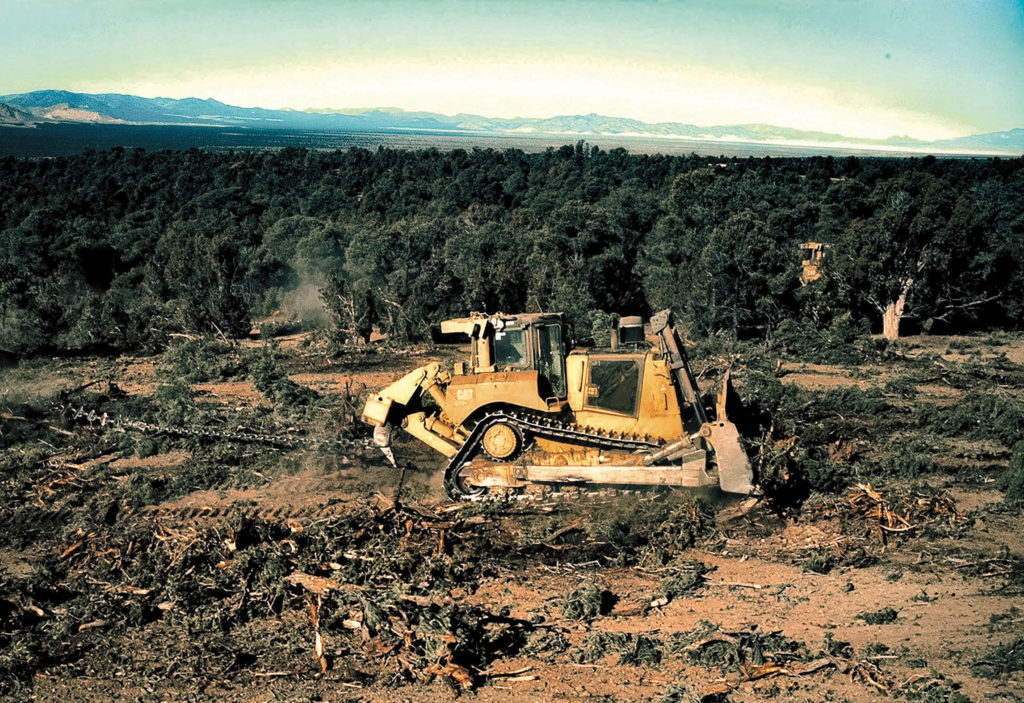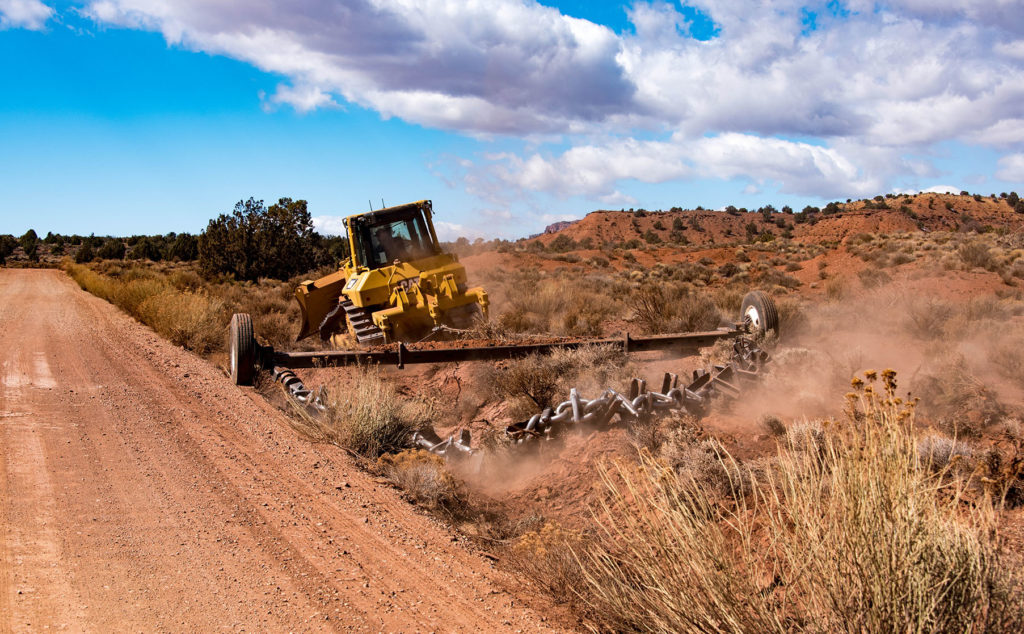A quiet morning in the desert, high on a remote plateau, you’ve hiked to find solitude and solace and are just beginning to enjoy the first rays of sunrise in Utah’s canyon country. Suddenly, the splendid silence you hiked so hard to reach is shattered by the rumble of engines and the heart-wrenching sound of pinyon pine and juniper trees being ripped from the ground. You race down from your sunrise perch to see a massive anchor chain being dragged between two bulldozers, scalping biological soil crust, uprooting vegetation, and leaving nothing but splinters in what was once an intact forest.
Surely, something is terribly wrong. Who has crept out at the crack of dawn to commit this crime? Making your way closer, you find a group of pickup trucks with the unmistakable white license plate, faint American flag in the background, clearly stating: U.S. Government, “For Official Use Only.”

Rolling, chopping, crushing, chaining, shredding—all words that describe destruction—are also words that, according to the Bureau of Land Management (BLM), should be associated with public lands. Every day, new vegetation removal projects are being rushed to completion on public lands across Utah and the West. In the last several issues of Redrock Wilderness, we’ve included updates on the BLM’s removal of pinyon pine, juniper, and sagebrush. Sadly, the agency shows no signs of slowing down in its quest to mechanically strip native vegetation from millions of acres of public land—all under the guise of “habitat improvement” or “watershed restoration” projects.
If you live in Utah or follow us on social media, you’ve likely seen SUWA’s advertisements showing a chaining project in Utah’s West Desert. This is the opening salvo in what will likely be a long fight against bad science, an entrenched and head-in-the-sand agency worldview, a lack of public scrutiny, and the rampant devastation these projects can have on Utah’s wilderness-quality lands.
Munch, Crunch, Scrape: How the Mulch Gets Made
Vegetation removal projects, most often called “treatments” by the BLM, take many forms. The simplest is hand-thinning: agency staff or contractors go out on foot with chainsaws, felling pinyon and juniper trees and scattering pieces around the site. More commonly, the agency employs heavy machinery. A particularly destructive method is mastication. A “bullhog” masticator attached to a front end loader or excavator mows down vegetation, turning living trees or sagebrush into a pile of woodchips and stumps.
“Chaining,” the cheapest, easiest, and most environmentally-destructive option, typically utilizes a large anchor chain dragged between two enormous bulldozers to rip trees out of the ground, roots and all. Bulldozers travel back and forth as the anchor chains, which can weigh more than 20,000 pounds, uproot hundreds of trees and other vegetation with every pass. The chains rake the ground, destroying soils, sagebrush, grasses, and forbs and leaving discarded trees in their wake, which litter the landscape for decades. The BLM all but abandoned chaining in the 1990s due to public outcry over its devastating impacts, but in the last decade we’ve seen its re-emergence as a favored method across Utah.
We’ve also recently seen a significant uptick in both the BLM’s eagerness to conduct vegetation removal activities and in the funding available for these projects—increasing the size and scope of projects, and the associated risk to Utah’s wilderness-quality lands.

Money Makes the Chains Drag the Ground
In 2006, a coalition was created with the express purpose of planning, promoting, and funding vegetation removal projects in Utah. The Utah Watershed Restoration Initiative (UWRI) includes, among others, the BLM, the Forest Service, the Utah Division of Wildlife Resources, and hunting advocacy organizations such as Sportsmen for Fish and Wildlife, the Mule Deer Foundation, and the Safari Club. Since UWRI’s inception, it has funnelled tens of millions of dollars toward vegetation projects on over one million acres of public, state, and private lands throughout Utah.
The money-pooling function of UWRI has produced a continual increase in proposed and approved projects on BLM-managed public lands in Utah—from the West Desert to the redrock of the Colorado Plateau, including wilderness study areas and other wilderness-quality lands. In the last 10 years, nearly every BLM field office in Utah has removed or proposed to remove native pinyon and juniper forests or sagebrush from lands proposed for protection in America’s Red Rock Wilderness Act.
It has become crystal clear that money, not sound science or best management practices, drives the BLM’s obsession with vegetation removal projects. For a cash-strapped federal agency, the choice between dollar signs and sound science has become sadly predictable.

Shifting Rationales: It’s a Bird! It’s a Deer! No . . . It’s Still a Cow
Vegetation removal projects have been occurring on public lands since the 1950s, and the agency’s rationale for these landscape-level gardening projects has been in continual flux. Sixty years ago, the BLM made no secret of the fact that chaining and other forms of vegetation removal were meant to get rid of “undesirable” native species and replace them with cattle-friendly forage grasses. As times have changed and public lands ranching has come under increased scrutiny, the BLM’s response has been to concoct new justifications for this decades-old practice. Instead of citing a single goal, the agency usually claims an assortment of unobjectionable “purposes” from the following list:
• Creating habitat for sensitive species, such as greater sage-grouse.
• Improving habitat for game species like deer and elk.
• Fire prevention.
• Improving water quality and watershed health.
• Restoring native vegetation by removing “invasive” or “encroaching” pinyon pine and juniper trees.
Not incidentally, all these project purposes improve forage for cattle. Rather than defining meaningful goals for vegetation removal projects, with clearly stated standards for judging success or failure, the BLM gives itself a cluster of justifications to hide behind and thus avoids any real scrutiny—let alone accountability. This also makes projects easier to fund and harder to challenge.
In reality, the idea that most of these benefits can be realized by removing vegetation lacks significant scientific support. For example, studies show that the native grasses and forbs favored by game and nongame species alike often fail to take hold in areas disturbed by heavy machinery. Science also tells us that disruptive treatments like chaining and bullhogging an area’s existing vegetation often result in the invasion of weeds such as cheatgrass and Russian thistle—an invitation to catastrophic wildfire.
These risks continue to increase as climate change results in a hotter, drier climate that favors proliferation of invasives. Mechanical removal methods like chaining tear up sensitive cryptobiotic soil crusts, which are critical to preventing erosion and retaining scarce moisture on the fragile Colorado Plateau, resulting in increased desertification rather than better watershed health.
What Do We Want? Science! When Do We Want It? After Peer Review!
What is most concerning is that the BLM and other proponents of large-scale vegetation removal projects simply do not acknowledge that these projects are not the cure-all for degraded ecosystems and that they come with a high-degree of risk. In fact, the science behind these million-dollar “experiments” on some of our most fragile public lands is uncertain and even contradictory.
SUWA’s campaign against large-scale vegetation removal seeks to educate the public about what we view as one of the most destructive practices currently aimed at wilderness-quality lands in the West. The necessity of this is evident in the most consistent response to our initial TV ad showing a chaining project—a shocked question: “Is this REALLY happening?!” Unfortunately, yes.
Our goal is to push the BLM towards cautious, defensible management practices rooted in consistent monitoring, rigorous science, and long-term native ecosystem health. We are not advocating that truly degraded ecosystems can never benefit from human help, merely that the agency must take a precautionary approach rather than automatically reaching for the most large-scale and heavy-handed actions first.
The BLM could, for example, easily take a number of low cost and low risk approaches from the outset. These include removing livestock from degraded areas, aerially applying native seed, and conducting small-scale field tests and comparing them to untreated exclosure areas to ensure that the proposed treatment method does in fact lead to a specific desired outcome. Never, ever, should scientific development and a results-based approach take a back seat to ease and cost-effectiveness. The BLM should also avoid surface-disturbing activities in wilderness-quality lands until they can prove that these projects will not result in unintended consequences.
This is a complicated subject, but it is important. These “treatments” show no sign of slowing and, in their current forms, pose a huge threat to the untrammeled nature of Utah’s redrock wilderness. The management practices of 60 years ago simply cannot be carried forward any further into this century—“sometimes it works, sometimes it doesn’t” is not judicious land management, it is Russian Roulette. Until the BLM shows that these projects can be done in ways that are more beneficial than harmful to natural ecosystems, we’ll be there, with your help, taking bullets out of the chamber.
—Kya Marienfeld
(From Redrock Wilderness newsletter, spring 2018 issue)

